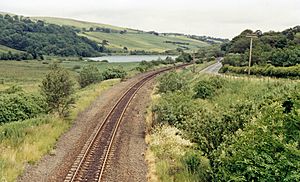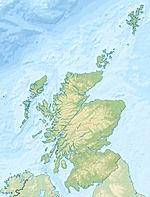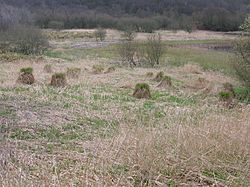Loch Libo facts for kids
Quick facts for kids Loch Libo |
|
|---|---|

Loch Libo and the railway to Glasgow
|
|
| Lua error in Module:Location_map at line 420: attempt to index field 'wikibase' (a nil value). | |
| Location | Uplawmoor, East Renfrewshire, Scotland |
| Lake type | Old freshwater loch |
| Primary inflows | Thorter Burn, rainfall and natural drainage |
| Primary outflows | Lugton Water |
| Basin countries | Scotland |
| Surface area | 24 acres (9.7 ha) |
| Average depth | Shallow |
| Surface elevation | 395 ft (120 m) |
| Islands | None |
| Settlements | Neilston |
Loch Libo is a beautiful freshwater loch (that's a Scottish word for lake!) located in East Renfrewshire, Scotland. It's close to the villages of Uplawmoor and Shillford. The Lugton Water river actually starts right here at the southern end of the loch, flowing for about 14 miles before joining another river, the River Garnock. The town of Neilston is also only about 3 miles away.
Contents
History of Loch Libo
The name 'Libo' is very old and might even come from a language spoken before Gaelic. The loch sits in a valley, with Caldwell Law hill to the north. Long ago, in the 1300s, it was called 'Loch le Bog Syde', which means 'the Bogside Loch'. Today, the Scottish Wildlife Trust (SWT) owns the loch and looks after it as a special nature reserve.
How People Use Loch Libo
Travel and Transport
A very old road, now called the A736 Lochlibo Road, used to run along the south side of the loch. Later, the Glasgow, Barrhead and Kilmarnock Joint Railway was built even closer to the water. There was once a train station nearby called Caldwell, which was later renamed Uplawmoor. This station was handy for visitors, like people who came to curl on the ice.
The station closed in 1966, but the railway line is still open. People can cross the tracks safely at a special crossing to get to the loch.
Fishing at the Loch
Loch Libo is home to many types of fish, including tench, eels, perch, pike, carp, and roach. However, it's mainly used by members of the Scottish Carp Group for fishing. You'll see signs around the loch shore explaining this. Old maps from 1895 show there used to be a boathouse on the northern side of the loch.
Curling on the Ice
Curling is a sport played on ice, and matches started happening at Loch Libo in 1885. A special house was built to store the curling stones. The Neilston Curling Club used to play here. They even got special deals from the railway company to travel with their curling stones between Neilston and Caldwell stations. A key for their clubhouse was kept at Caldwell station.
In 1919, the club moved to a different location called Kirkton Dam. They even moved their curling stone house from Loch Libo! The loch and the nearby Neilston Pad hill are still featured on the Neilston Curling Club's badge.
Maps and History
Old maps show that Loch Libo is generally oval-shaped and shallow, but it gets quite deep in the middle. Maps from the 1600s, like Timothy Pont's and Blaeu's, show the name spelled as 'Loch Libo'. Another map by John Ainslie calls it 'Loch Lebe'. Maps continued to show a boathouse on the loch until 1969.
Water Flow and Sources
The Lugton Water river starts at the southwest end of Loch Libo. Another stream, the Thorter Burn, was redirected to flow into the loch when the Glasgow, Barrhead and Kilmarnock Joint Railway was built. The Caldwell Law Burn also flows into the loch from the north. Plus, a stream from Shillford adds water, along with rainfall and natural drainage.
Coal Mining History
Long ago, in the 1780s, there was a coal mine near the southern edge of the loch. In 1793, something unexpected happened: the loch's water broke into the mine! This caused the mine to flood.
Later, around 1830, the mine was reopened by a company called Loch Coal Co. They dug much deeper shafts and found two different coal seams, each about four feet thick. These mines were eventually completely worked out many years ago.
Nature and Wildlife
Since 1972, Loch Libo and part of the nearby Caldwell-Lawside Wood have been recognized as a Site of Special Scientific Interest (SSSI). This means it's a very important place for nature. It's also a wildlife site managed by the Scottish Wildlife Trust (SWT), who own the loch.
Plants and Vegetation
Loch Libo is a great example of a eutrophic loch in East Renfrewshire. This means it's rich in nutrients, which helps many plants grow. You can find lots of aquatic plants (those that grow in water) and emergent vegetation (plants that grow out of the water).
Some important plants here include the rare cowbane Cicuta virosa. You can also find locally uncommon plants like greater tussock sedge Carex paniculata and lesser pond sedge Carex acutiformis. Other rare sedges and water parsnip Berula erecta also grow here.
Animals and Wildlife
Many different birds have been seen at Loch Libo. These include jack snipe, common snipe, grey heron, whooper swan, mute swan, teal, wigeon, goldeneye, tufted duck, mallard, coot, and moorhen. You might also spot birds of prey like buzzards and sparrowhawks, and smaller birds like wrens, coal tits, great tits, and blue tits.
Besides birds, other animals live here too! You might find bats, deer, mice, otters, common frogs, common toads, smooth and palmate newts, and even water voles.
Fun Facts
There's a geocache hidden in the Caldwell-Lawside Wood for those who enjoy treasure hunting!




